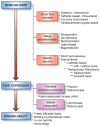Angiogenic gene therapy in cardiovascular diseases: dream or vision?
- PMID: 28073865
- PMCID: PMC5837788
- DOI: 10.1093/eurheartj/ehw547
Angiogenic gene therapy in cardiovascular diseases: dream or vision?
Abstract
Chronic cardiovascular diseases are significant health problems. Although current treatment strategies have tremendously improved disease management, up to 30% of these patients cannot be successfully treated with current treatment approaches and new treatment strategies are clearly needed. Gene therapy and therapeutic vascular growth may provide a new treatment option for these patients. Several growth factors, like vascular endothelial growth factors, fibroblast growth factors and hepatocyte growth factor have been tested in clinical trials. However, apart from demonstration of increased vascularity, very few results with clinical significance have been obtained. Problems with gene transfer efficiency, short duration of transgene expression, selection of endpoints, and suboptimal patients for gene therapy have been recognized. Ongoing gene therapy trials have included improvements in study protocols, vector delivery and endpoints, addressing the identified problems. Better, targeted delivery systems and new, more optimal growth factors have been taken to clinical testing. Recent advances in these areas will be discussed and the concept of angiogenic therapy as a sole treatment is re-evaluated. A combination with regenerative therapies or standard revascularization operations might be needed to improve tissue function and clinical benefits.
Keywords: Angiogenesis; Coronary heart disease; Gene delivery; Gene therapy; Growth factors; Heart failure; Peripheral arterial disease.
Published on behalf of the European Society of Cardiology. All rights reserved. © The Author 2017. For Permissions, please email: journals.permissions@oup.com.
Figures




References
-
- Mozaffarian D, Benjamin EJ, Go AS, Arnett DK, Blaha MJ, Cushman M, de Ferranti S, Després JP, Fullerton HJ, Howard VJ, Huffman MD, Judd SE, Kissela BM, Lackland DT, Lichtman JH, Lisabeth LD, Liu S, Mackey RH, Matchar DB, McGuire DK, Mohler ER, Moy CS, Muntner P, Mussolino ME, Nasir K, Neumar RW, Nichol G, Palaniappan L, Pandey DK, Reeves MJ, Rodriguez CJ, Sorlie PD, Stein J, Towfighi A, Turan TN, Virani SS, Willey JZ, Woo D, Yeh RW, Turner MB.. American heart association statistics committee and stroke statistics subcommittee. heart disease and stroke statistics - 2016 Update. Circulation 2015;131:e29–322. - PubMed
-
- Townsend N, Nichols M, Scarborough P, Rayner M.. Cardiovascular disease in Europe - Epidemiological update 2015. Eur. Heart J 2015;36:2696–2705. - PubMed
-
- Ferrara N, Alitalo K.. Clinical applications of angiogenic growth factors and their inhibitors. Nat Med 1999;5:1359–1364. - PubMed
-
- Yla-Herttuala S, Rissanen TT, Vajanto I, Hartikainen J.. Vascular endothelial growth factors: biology and current status of clinical applications in cardiovascular medicine. J Am Coll Cardiol 2007;49:1015–1026. - PubMed
-
- Rissanen TT, Yla-Herttuala S.. Current status of cardiovascular gene therapy. Mol Ther 2007;15:1233–1247. - PubMed
Publication types
MeSH terms
Substances
Grants and funding
LinkOut - more resources
Full Text Sources
Other Literature Sources
Medical

